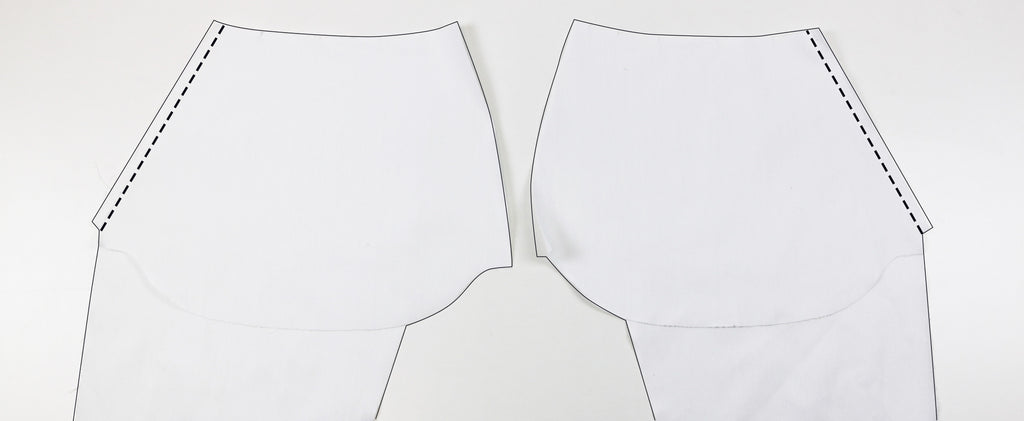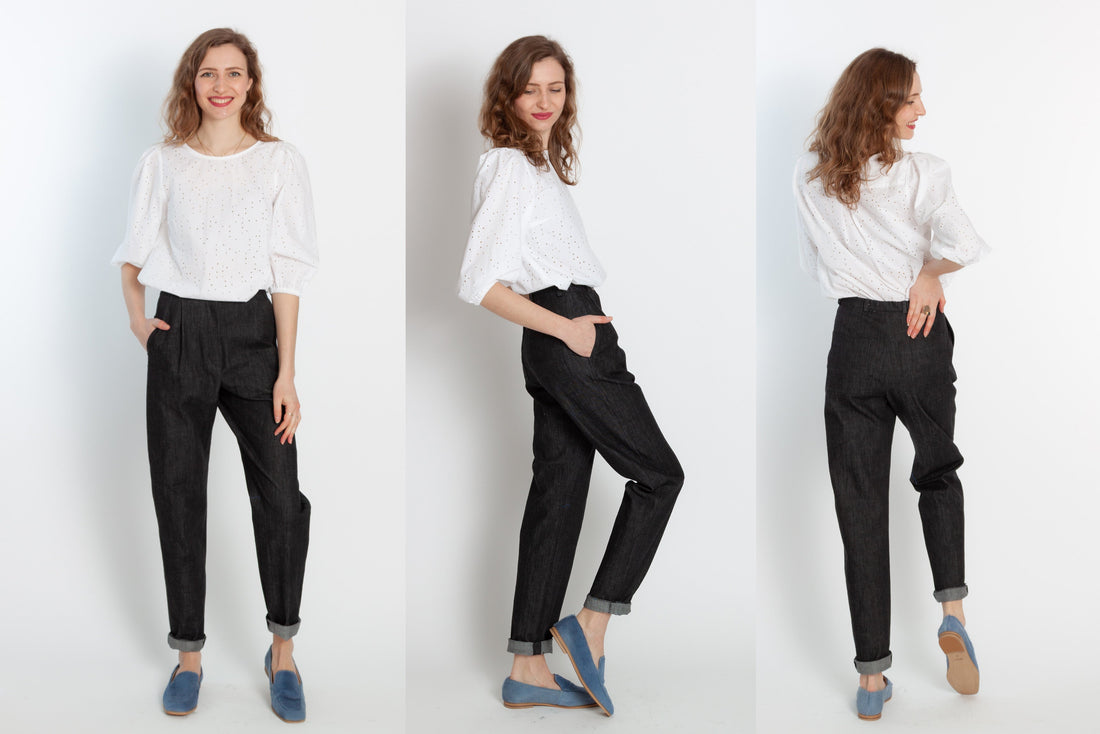The modern high waist pants shape you can convert with the pattern Ücke. The jeans look is created by the slanted pockets and the decorative patch pockets. In terms of comfort, an elastic tape in the back waistband and small pleats in the front support.
The pants are 108 cm long, including waistband.
Ücke was sewn from a stretch denim fabric in this tutorial.
In advance for you as info:
Materials required:
We recommend a heavy and flowing fabric, eg a soft denim with elastane.
Sizes 34-42
- Outer fabric 2.20 m (140 cm wide)
Sizes 44-50
- Outer fabric 2.50 m (140 cm wide)
Sizes 34-50
- interlining 0.10 m (90 cm wide)
- elastic tape 0.35 - 0.50 m (3 cm wide)
- Knob 1 piece 12mm diameter
- Ripper 1 piece 17 cm long
cutting:
Cut the pattern pieces from your upper, lining and off interlining to. Place the fabric with the right side of the fabric facing up. The pattern pieces should all lie with the lettering facing up. Align the threadl up arrow always in the same direction for all pieces and parallel to the selvage of the fabric. Transfer all notches from the pattern by making a 3mm incision with scissors or chalk. . Clip the seam allowance in the fabric break, because this is always a center . Marks define positions of dart endings pocket positions, etc. Transfer these either with chalk or pin. n. All outer fabric parts that will be completely covered with interlining are best cut roughly first. After you have fixed the interlining , cut them out exactly. Here is also a video about gluing and fixing pattern pieces.
If you want to make your skirt from corduroy, then note that corduroy is cut against the grain. For this we have a video for you.
If you want to make your skirts out of plaid, note that the pattern pieces of the pockets and the entire waistband are cut in diagonal threadline.
Dagmar shows you the best way to cut plaid in this video.


You need fabric:
- 2x back pant opposite
- 2x front trousers opposite
- 1x belt loop
- 2x pocket bags opposite
- 1x underlap
- 2x bag back bottom
- 2x bag back


also with interlining:
- 1x waistband
- 1x overlap zipper

also with interlining tape:
- 2x pocket opening on pocket bag
Sewing instructions:
To sew these trousers you will need a sewing machine and an overlock sewing machine, alternatively use the zigzag stitch on your sewing machine to neaten the raw edges.
If you are using a seam zip, you will also need the right presser foot for your sewing machine. In addition to the description, the colored lines on the pictures show you where to sew a seam or glue something.
When sewing, pay attention to the seam allowance included in the pattern. Seam allowances that are not specially marked are 1cm wide!
Have fun sewing!

Prepare the left front piece as follows: Along the line in the pattern, cut away the overlap of the left side of the body and press it according to the pattern.

Start your pants with the front pockets. To do this, place pocket bag right sides together on the respective front trousers and topstitch through with 1cm. Press the seam allowances towards the bag to be able to turn it right side out later.

Here you can see the sewn pocket bag and ironed top or underlap.

Turn the pouch right side out and topstitch the opening close to the edge and quilting foot wide.

Place the pocket bag right sides together and stitch the bottom edge closed. Pay attention to the notches in the cut. Finish the seam allowances together.

Secure the front pocket with a 3cm topstitching along the bottom and top edge and quilting foot width.

Now come to neatening the pattern pieces all around. Overcast the prepared front pieces,...

... the back parts,...

... the top and bottom edges of the back pockets, the top edge of the bottom back pocket, the underlap and one long side of the belt loop.


Now prepare the back patch pocket by placing both blanks right sides together and sewing them together. Then press the serged seam allowances apart.

Stitch the seam allowances flat by stitching them close to the edge on both sides. I also recommend sewing an auxiliary seam with a large stitch in the pocket curves, as the curves are easier to press afterwards.
In this video we show you how to use the ironing template of the back patch pocket.

Now press the seam allowances all around and the pocket opening. Use the template provided in the pattern.

Topstitch the pocket opening according to the pattern.

Now place the prepared back pockets right sides together on the markings in the cut of the back trousers panels and secure both pockets with a close edge and topstitching foot-wide seam all around.

The front pants are right sides together on the back pant and you close the side seam, which is then ironed apart.

Prepare the hem according to the pattern and press it.

Now we come to the inner leg seams of the trouser legs, which are closed right sides together. Orientate yourself on the notches in the cut and stretch out the shorter section of back pant a little. Press these seam allowances apart as well.

The next step is to close the inseam. To do this, turn one pant leg right side out (right side ) and the other pant leg left side out (left side ). Pin the trouser leg (with the right side facing out) into the other trouser leg. Pin your seat seam together so it's nice and straight, and sew them together a short distance (see photo). Make sure that the inside leg seams are exactly on top of each other.
For a better understanding of how to sew in your zipper and do all the preparations beforehand, we have prepared a video for you here.

Pick up the zipper and the prepared underlay. Sew the zipper to the underlap. Do not stitch too close to the zipper bar so that the slider does not get caught later.

The ironed underlap is pinned and sewn to the zipper side with facing to the left side of the body.

Pin the front centers together to help you. So you can pin the other side of the zipper better.

Lay the pants neatly in front of you so that the overlap covers the zipper and pin the overlap to the zipper with a needle. Then fold the sewn-on underlap to the side and at 2cm (or 3cm wide) next to the fabric fold of the center front, sew the zipper through the overlap . End about 2cm above the zipper end and lock this place.

Now stitch through the decorative seam and secure the overlap while the underlap is folded away. Bartack just before the underlap begins.

Fold the underlap back under the zipper and topstitch (depending on the design) in an arc or diagonally to the center front on the corner of the inseam through overlap, zipper and underlap , lock at the inseam.

Now close the remaining section of the seat seam right sides together and topstitch it twice to double-lock. Press the seam allowances of the center back apart to the snap in the crotch.


For the belt loop cut, press the untrimmed edge 1cm over and the trimmed edge 1cm over. Finally, topstitch along the long sides, each 0.2cm wide. Cut the strip into 6 pieces of equal length.

Lay the pleats according to the pattern and secure them with a topstitching foot-wide auxiliary seam.

With right sides together, stitch your cut belt loops to the markings in the pattern just below the edge and 1.5cm below the edge.

Now come to the processing of the waistband. Iron the fold of the waistband according to the pattern, wrong sides together. Then press the seam allowance of the inner waistband with 1cm.

Now fold the waistband on top of each other and sew an auxiliary seam with a large stitch right next to the folded edge of the inner waistband, on the outer waistband.

Now sew the waistband right sides together to the pants. Make sure to topstitch to the left of the auxiliary seam of the outer waistband. Press the seam allowances up. Also check that the height of the front waistband is correct when you close the zipper.

The short sections of the waistband are stitched right to right.

Now come to the processing of the tunnel in the back waistband, in which later the elastic tape will be pulled in. Topstitch the inner waistband in the shadow of the seam from side seam to side seam.

You can then pull the elastic tape with the correct length into the drawstring and tighten it at the side seam.

Topstitch the front waistband pieces close to the edge and stitch through to the respective side seams.

Place the belt loops up, check the desired length for a belt, fold over 1cm seam allowance and tuck it close to the edge. Also make the button hole on the right side of the body.

Place the belt loops up, check the desired length for a belt, fold over 1cm seam allowance and cinch it close to the edge.

Sew on a matching button.
Your ÜCKE is ready !
If you get stuck or have any questions or if you have any questions, please feel free to contact us by email at info@schnittmuster-berlin.de. We will answer as soon as possible.
Have lots of fun with your new designer piece!
Sincerely yours Sewing Pattern Berlin Team.


